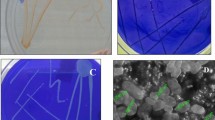Abstract
The ability of a newly isolated Pseudomonas citronellolis KHA to degrade diesel oil and to synthesize fatty acid esters has been screened in aerobic batch cultures. The microorganism was able to grow with diesel oil at initial concentrations up to 126 g/l, with optimal growth at 25 g/l. Strain KHA has produced compounds showing strong emulsifying properties (E24 = 75% at the end of the exponential growth phase). The crude extract reduces the surface tension of water from 72 mN m−1 down to 35 mN m−1 with a corresponding minimal concentration value of 60 mg/l. GC and GC–MS analysis of crude product show that the major components are those of hexadecanoic acid propyl ester and octadecanoic acid propyl ester, which have potential for applications in cosmetics, pharmaceutical and foods industries. In addition, strain KHA represents a valuable source of compounds with surface-active properties and potential for the application in clean up of the sites contaminated with hydrocarbons.




Similar content being viewed by others
References
Arino S, Marchal R, Vandecasteele JP et al (1998) Involvement of a rhamnolipid—producing strain of Pseudomonas aeruginosa in the degradation of polycyclic aromatic hydrocarbons by a bacterial community. J Appl Microbiol 84(5):769–776
Ashbi R, Soleiman D, Foglia T et al (2006) The use of fatty acid-esters to enhance free acid sophorolipid synthesis. Biotechnol Lett 28:253–260
Bouchez-Naïtali M, Rakatozafy H, Marchal R, Leveau JY, Vandecasteele JP et al (1999) Diversity of bacterial strains degrading hexadecane in relation to the mode of substrate uptake. J Appl Microbiol 86:421–428
Button DK (1985) Kinetics of nutrient-limited transport and microbial growth. Microbiol Rev 49(3):270–297
Chang R-C, Chou S-J, Shaw J-F et al (2001) Synthesis of fatty acid esters by recombinant Staphylococcus epidermidis lipases in aqueous environment. J Agric Food Chem 49(5):2619–2622
Choi MH, Yoon SC (1994) Polyester biosynthesis characteristics of Pscitronellolis grown on various carbon sources, including 3-methyl-branched substrates. Appl Environ Microbiol 60(9):3245–3254
Cooper DG, Goldenberg BG (1987) Surface-active agents from two Bacillus species. Appl Environ Microbiol 53(2):224–229
Desaï JD, Banat IM (1997) Microbial production of surfactants and their commercial potential. Microbiol Mol Biol Rev 61(1):47–64
Ghosh M, Bhattacharyya DK (1997) Enzymatic alcoholysis reaction of soy phospholipids. J Am Oil Chem Soc 74(5):597–599
Haas MJ, Bloomer S, Scott K et al (2002) Process for the production of fatty acid alkyl esters. U.S. Patent 6:399–800
Herrera Y, Okoh AI, Alvarez L, Robledo N, Trejo-Hernandez MR et al (2008) Biodegradation of 2,4-dichlorophenol by a Bacillus consortium. World J Microbiol Biotechnol 24:55–60
Kanaly RA, Harayama S (2000) Biodegradation of high-molecular weight polycyclic aromatic hydrocarbons by bacteria. J Bacteriol 182(8):2059–2067
Kim J, Altreter DH, Clark DS, Dordick JS et al (1998) Rapid synthesis of fatty acid esters for use as potential food flavours. J Am Oil Chem Soc 75(9):1109–1113
Kuo TM, Ray KJ, Manthey LK et al (2003) A facile reactor process for producing 7,10-dihydroxy-8(E)-octadecanoic acid from oleic acid conversion by Pseudomonas aeruginosa strain PR3. Biotechnol Lett 25(1):29–33
Lang E, Griese B, Spröder C, Schuman P, Steffen M, Verbarg S et al (2007) Characterisation of Pseudomonas azelaica DSM 9128, leading to emended descriptions of Pseudomonas citronellolis Seubert 1960 (Approved Lists 1980) and Pseudomonas nitroreducens lisuka and Komagana 1964 (Approved Lists 1980), including Pseudomonas multiresinivorans as its later heterotypic synonym. Int J Syst Evol Microbiol 57:878–882
Leahy JG, Colwell RR (1990) Microbial degradation of hydrocarbons in the environment. Microbiol Rev 54(3):305–315
Marchal N, Bourdon JL, Richard C, Buttiaux R, Obré A (1982) Les milieux de culturepour l’isolement et l’identification biochimique des bactéries. Doin Editeurs, Paris
Moreau B, Lognay GC, Blecker C, Brohée JC, Chéry F, Rollin P, Paquot M, Marlier M et al (2004) Synthesis of novel D-glucuronic acid fatty esters using Candida antartica lipase in tert-butanol. Biotechnol Lett. 26(5):419–424
Rapp P, Gabriel-Jürgens LHE (2003) Degradation of alkanes and highly chlorinated benzenes, and production of biosurfactants, by a psychrophilic Rhodococcus sp. and genetic characterization of its chorobenzene dioxygenase. Microbiology 149:2879–2890
Seubert W (1960) Degradation of isoprenoid compounds by microorganisms. J Bacteriol 79(3):426–434
Van Dyke MI, Lee H, Trevors JT et al (1991) Applications of microbial surfactants. Biotech Adv 9:241–252
Whyte LG, Slagman SJ, Pietrantonio F, Bourbonnière L, Koval SF, Lawrence JR, Inniss WE, Greer CW et al (1999) Physiological adaptations involved in alkane assimilation at a low temperature by Rhodococcus sp. strain Q15. Appl Environ Microbiol 65(7):2961–2968
Zhang Y, Miller RM (1995) Effect of rhamnolipid (biosurfactant) structure on solubilization and biodegradation of n-alkanes. Appl Environ Microbiol 61(6):2247–2251
Acknowledgments
We thank Professor ACHOUAK Wafa (LEMiR, UMR 6191 CNRS-CEA-Univ. Aix-Marseille II, CEA Cadarache—France) for determination of the nucleotide sequence of strain KHA. We thank also Professor MEKLATI Y. B. (CRAPC, Algiers) for GC and GC-MS analysis.
Author information
Authors and Affiliations
Corresponding author
Rights and permissions
About this article
Cite this article
Sadouk, Z., Tazerouti, A. & Hacene, H. Biodegradation of diesel oil and production of fatty acid esters by a newly isolated Pseudomonas citronellolis KHA. World J Microbiol Biotechnol 25, 65–70 (2009). https://doi.org/10.1007/s11274-008-9863-7
Received:
Accepted:
Published:
Issue Date:
DOI: https://doi.org/10.1007/s11274-008-9863-7




